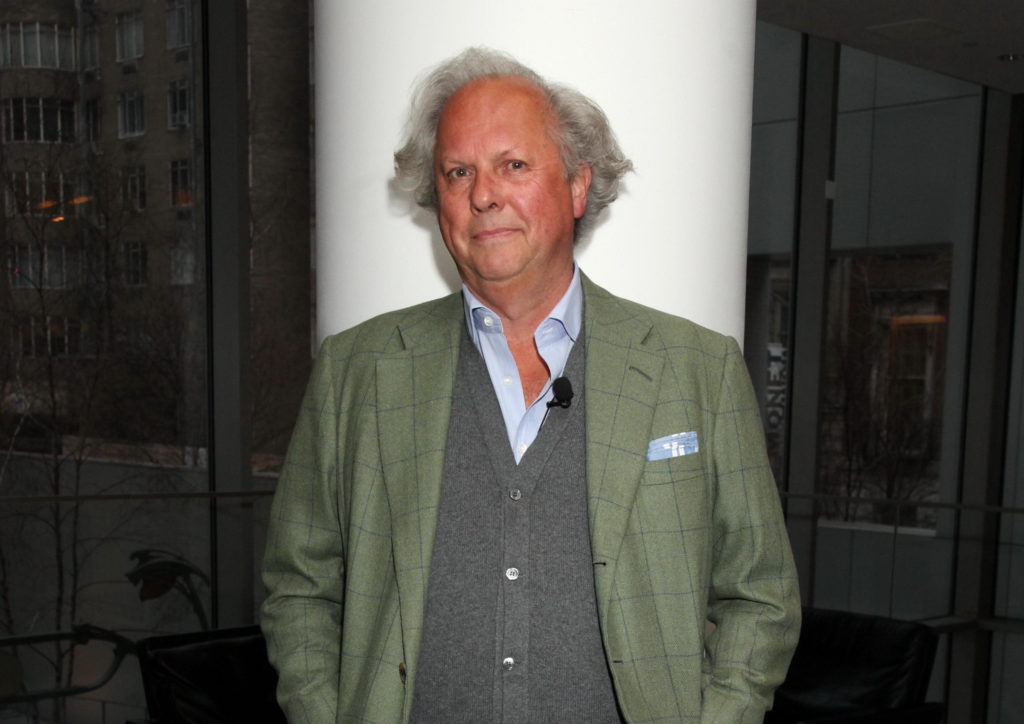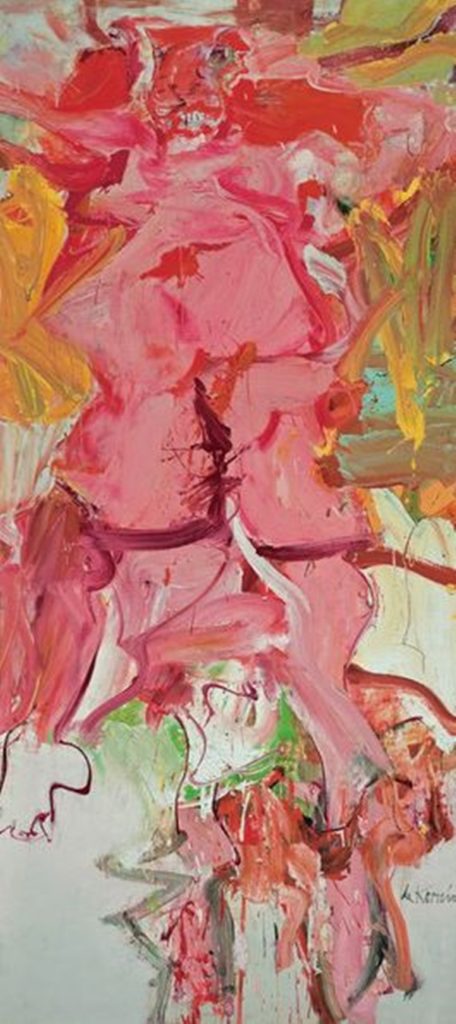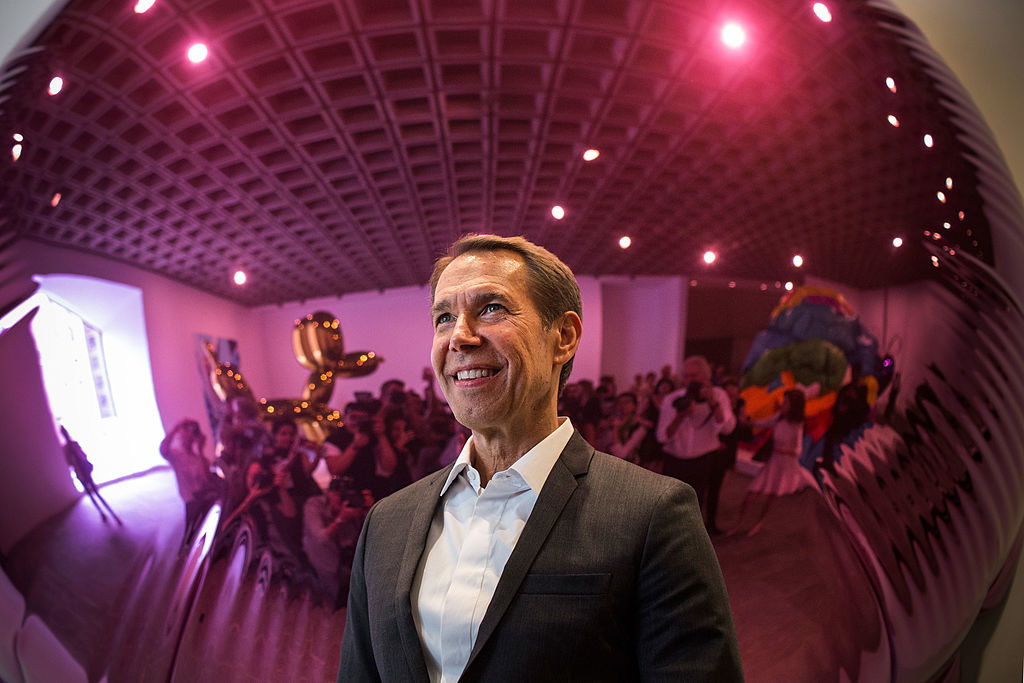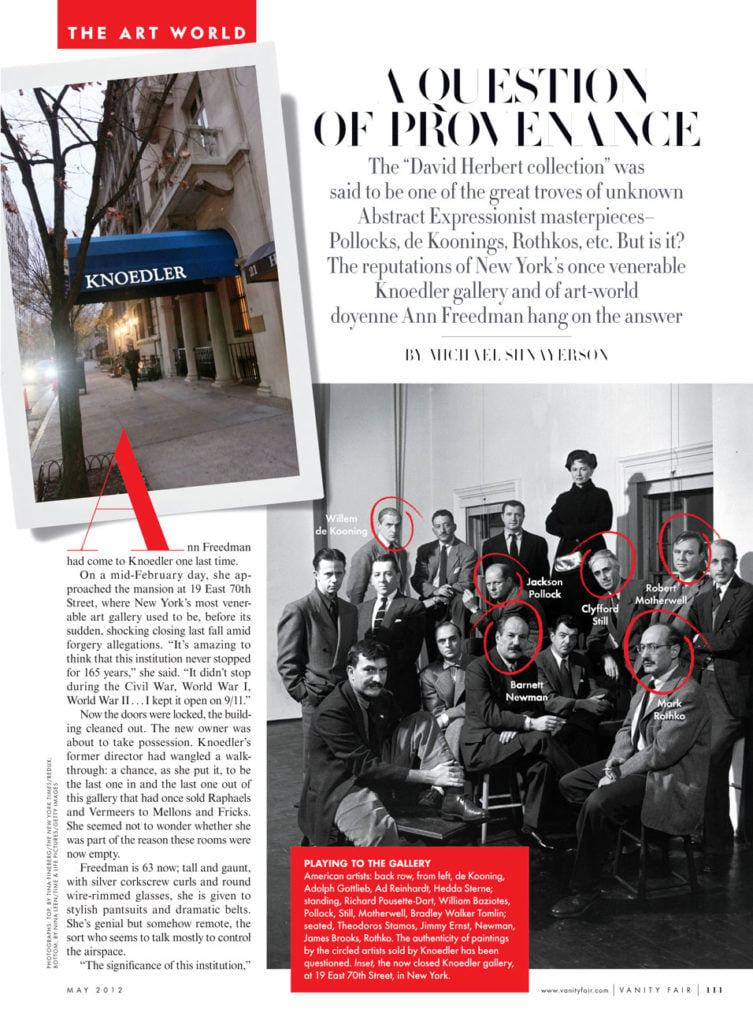Art World
Koons, Cons, and Lots of Cash: 7 of Vanity Fair’s Glossiest Art-World Scoops From the Graydon Carter Era
Revisit the art stories that riveted us.

Revisit the art stories that riveted us.

Caroline Goldstein &
Eileen Kinsella

Over the past quarter century, Vanity Fair’s editor-in-chief Graydon Carter has guided its coverage of not only presidential campaigns and celebrity scandals, but also numerous episodes of art-world intrigue.
His successor Radhika Jones—whose impressive résumé includes a stint at Artforum—prepares to take the helm next month at a time of belt-tightening and change for the publication. (She will be tasked with slashing the magazine’s budget by 30 percent.)
But rather than worry about that, why not take a walk down memory lane, where the pages are glossy, the photo spreads are lavish, and the pay is ample?
Since Carter joined the magazine in 1992, VF has managed to have its say on many of the biggest art-world names and scandals. Amy Fine Collins delved into Frida Kahlo’s psyche in 1995. The late Ingrid Sischy profiled Francesco Clemente, Keith Haring, and Jeff Koons (twice). And don’t forget Vanity Fair‘s 2013 poll to determine the greatest living artist. (Gerhard Richter came out on top, despite the fact that Richard Serra—god love him—voted for himself.)
Below, a round-up of our favorite market dives and hard-hitting exposés of the past quarter-century for your reading pleasure.

Willem de Kooning, Woman, Sag Harbor (1964).
Photo: Courtesy of Hirshhorn Museum and Sculpture Garden, Smithsonian Institution, Washington, DC.,
2011 The Willem de Kooning Foundation / Artists Rights Society (ARS), New York.
“Ruth Kligman’s Post-Pollock Life” by Mark Stevens, May 1994
The Gist: Although the headline purports to dig into the life of Ruth Kligman, a lover of Jackson Pollock and, later, Willem de Kooning, the story is best enjoyed as a throwback to the freewheeling New York art scene of the ’50s and ’60s. It traces the rise of de Kooning (who, at the time of publishing, was just shy of his 90th birthday) after Pollock’s alcohol-fueled downward spiral ended in a fatal car crash.
Choice Quote: Elaine, de Kooning’s wife, called the 1950s “a decade-long bender.”
The Dish: The name-dropping alone makes this piece worth revisiting. Stevens recalls that de Kooning was annoyed that fellow artist Arshile Gorky did not do enough to talk him up to rich friends like Peggy Guggenheim.
Dia:Beacon. Photo: Bill Jacobson studio, New York, courtesy Dia Art Foundation, New York.
“Remains of the Dia“ by Bob Colacello, September 1996
The Gist: It’s easy to forget that Dia, the prominent temple of Minimalist art, has a backstory fit for a soap opera. This juicy chronicle by VF‘s celebrated contributor Bob Colacello captures the oil money, family dysfunction, and behind-the-scenes plotting that shaped the institution in its early years—and ultimately led to what Colacello calls a “second coup.”
Choice Quote: “Holding a lot of the work of one artist becomes a power play,” Coosje van Bruggen, the wife of Claes Oldenburg, said of Dia’s approach to collecting. “You create freedom for the artist, but the artist can become a prisoner…. They wanted Claes to become part of Dia, but he said no.”
The Dish: The “second coup” came under Michael Govan’s directorship in the late ’90s. Four relatively new board members threatened to withhold donations unless the leadership structure changed. What followed was a mass resignation: Dia’s chairman of 10 years, Ashton Hawkins, and seven other board members left. The situation roiled the clubby New York art world, but also set the scene for Dia’s game-changing expansion—and Colacello had a front-row seat.

Jeff Koons at the Whitney Museum. Photo by Andrew Burton/Getty Images.
“Koons, High and Low” by Ingrid Sischy, March 2001
The Gist: Many remember Sischy’s 2014 profile of Koons ahead of his Whitney retrospective (or, more accurately, they remember the photo shoot, for which the artist notoriously posed nude). But it’s her 2001 profile of the artist that serves as an enduring historical document. At the time, Koons was mired in personal legal troubles—a torturous custody battle with his ex-wife—and had nearly bankrupted his dealers to create his “Celebration” series. At this vulnerable moment, Sischy chronicles his roots—and his quest for a comeback.
Choice Quote: “I’ve made what the Beatles would have made if they had made sculpture,” Koons said. “Nobody ever said that the Beatles’ music was not on a high level, but it appealed to a mass audience. That’s what I want to do.”
The Dish: Sischy got a rare glimpse of the relationship that spawned Koons’s notorious “Made in Heaven” series, which captures him in flagrante delicto with his ex-wife, Italian porn star-turned-politician Ilona Staller. “Between her exaggerated sweetness and his courteousness the effect was a bit like hanging out with a Hallmark card,” Sischy writes.
“Judging Andy” by Michael Shnayerson, November 2003
The Gist: Shnayerson explores the controversial and highly contested authentication procedures of the then-powerful Andy Warhol Art Authentication Board, an arm of the Andy Warhol Foundation. No panel tasked with determining authenticity has “seemed so capricious,” he writes. “None has stirred such indignation, such loathing, and such fear.”
Choice Quote: “My sense is that if it’s a charmed member of the inner circle they’re inclined to accept it,” dealer Irving Blum said of works coming up for review. “And if it comes from another source they’re inclined not to. It’s arbitrary, I believe.”
The Dish: Years later, following a bruising legal battle with a disgruntled collector, the board announced it would disband in early 2012. The decision set a powerful precedent, and numerous other authentication boards have since followed suit. Consider the VF story a primer on an issue that would go on to vex both the art market and art scholarship for the next decade.
“The Greatest Fake-Art Scam in History?“ by Joshua Hammer, October 2010
The Gist: The story serves as a comprehensive account of the rise and fall of husband-and-wife duo Wolfgang and Helene Beltracchi, who pulled the wool over the eyes of the art world by successfully selling forgeries painted in the style of Max Ernst, Fernand Léger, and others. (Wolfgang painted; Helene sold.) In 2010, authorities arrested the Beltracchis. Though the pair admitted to forging 14 paintings, Wolfgang has since claimed to have created hundreds of works by more than 50 artists.
Choice Quote: “You have to know about the artist’s past, present, and future,” Wolfgang said of his strategy. “You have to know how the painter moved and how much time it took him to complete a work.”
The Dish: The Beltracchis were fully committed to the stories they concocted. In one instance, Helene even posed as her late grandmother in an artificially aged photograph to add credibility to the paintings’ supposed provenance. Many high-profile figures fell victim to the scam, including former Centre Pompidou director Werner Spies, who certified a number of the fake works, and actor Steve Martin, who bought one.
“Qatar Purchases Cézanne’s The Card Players for More Than $250 Million, Highest Price Ever for a Work of Art” by Alexandra Peers, February 2012
The Gist: Just before Greek shipping magnate George Embiricos died, his treasured painting—the last remaining canvas in Paul Cézanne’s series “The Card Players” in private hands—was up for grabs. The four other works in the series are held by the Metropolitan Museum of Art, the Musée d’Orsay, the Courtauld, and the Barnes Foundation. Eyebrows around the globe were raised when VF reported that Qatar—which had by then emerged as a powerful market player—was the buyer.
Choice Quote: “For a nation in the midst of building a museum empire, it’s instant cred.”
The Dish: When VF broke the news of the sale, it was the highest price ever paid—publicly or privately—for a work of art. (Of course, that designation did not last.) It is rumored that mega-dealers William Acquavella and Larry Gagosian both made offers on the work, but the oil-rich royal family trumped them with little fanfare and a cool $250 million bid.

Courtesy Vanity Fair.
“A Question of Provenance” by Michael Shnayerson, May 2012
The Gist: Shnayerson was one of the first to delve into the swirling rumors of the art forgery scandal that ultimately brought down the 165-year-old Knoedler Gallery. Now, the story of the mystery collector Mr. X, who secretly compiled a world-class collection of Abstract Expressionist masterworks, is the stuff of legend. But what stands out in retrospect is that Shnayerson’s reporting was conducted prior to the US Department of Justice investigation that conclusively revealed that the works had all been created by an amateur painter in Queens.
Choice Quote: At the time, Knoedler staff were still maintaining that the artworks were authentic. “The significance of this institution will not rest on the David Herbert collection,” Knoedler’s longtime president Ann Freedman said. “But it will,” Shnayerson wrote.
The Dish: Anonymously, dealers admitted they had been skeptical of the cache of previously undiscovered works, which popped up with regularity in Knoedler’s booth at the Art Dealers Association of America’s annual art fair at the Park Avenue Armory. “Everyone would say, ‘Huh?’” one said. “You’d look it up, and there wouldn’t be any record on it.”